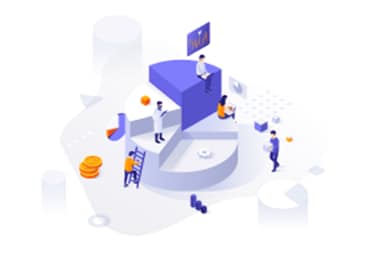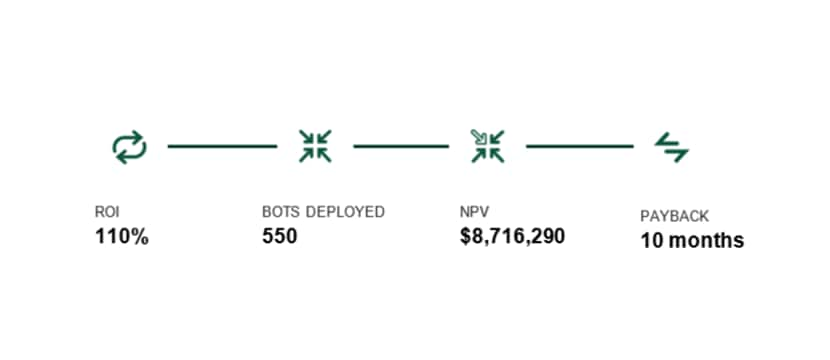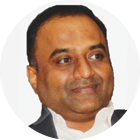

Summary
The Automation Implementation at Philips with AssistEdge RPA is one of the most complex and largest finance transformation programs in the world. Collaborative efforts led by Philips Finance leadership, powered by the technology capability of AssistEdge RPA and delivery expertise of Infosys BPM, delivered significant cost savings and business benefits over the last three years. With an ROI of 159%, this program exemplifies the power of Automation when applied as a core business strategy, in a well-structured and planned manner.
EdgeVerve commissioned Forrester Consulting to conduct a Total Economic Impact™ (TEI) study and examine the potential return on investment (ROI) enterprises may realize by deploying the EdgeVerve AssistEdge RPA platform. The purpose of this study is to provide readers with a framework to evaluate the potential financial impact of the AssistEdge RPA platform on their organizations. To better understand the benefits, costs, and risks associated with this investment, Forrester interviewed one EdgeVerve AssistEdge customer, Royal Philips, and used this experience to project a three-year financial analysis.
Forrester interviewed Royal Philips with the following characteristics in mind :
-
Large multinational conglomerate, headquartered in Europe, focusing on electronics and health technology
-
Manages finance operations through Infosys BPM, employing 1,200 Infosys employees across finance processes

Key Objectives of Automation Implementation
Royal Philips finance BPM operations, managed by Infosys, saw a significant impact on time efficiency in finance tasks and cost savings on automated FTE hours with RPA implementation. Given the level of manual operations in the conventional finance task functions, Philips had adopted a Hoshin strategy to eliminate, simplify, standardize, and automate finance operations processes. Their main objective of using RPA was to provide:
-
Automation of 1 million work hours in finance operations over three years of deployment
-
Efficient, improved, and consistent performance across finance operations
-
Centralized BPM operations and enabled end-to-end automation across the finance operations domain
Setting foot on a Successful Automation journey
As Philips looked to expand its automation capabilities, it worked with EdgeVerve and Infosys BPM to define strategic use cases for RPA implementation within the existing Infosys BPM functions. Based on design principles, and change management, standard processes for RPA were defined and implemented from 2018 for the customer.
After investing in the EdgeVerve AssistEdge platform, Philips has been able to automate tasks across 220 use cases in finance BPM operations, including automation, elimination, and standardization. The automated FTE hours and productivity gains from this implementation enabled cost savings for Philips.
Reaping the Benefits
After investing in the EdgeVerve AssistEdge platform, Philips has been able to automate almost 31% of their BPM finance workforce. Some key benefits are as listed below:
-
Quantified Benefits:
Risk-adjusted present value (PV) quantified benefits include:
RPA implementation saw BPM staff eliminate a total of 49,348 hours across three years in payroll posting processes. Cumulatively, this productivity gain saw a net present value of $993,137 over a three-year period.
Automated dunning process with RPA, especially from the second year of the RPA program, saw a total of 21,320 hours eliminated in the cash collections processes.
Standardizing and automating reconciliation processes saw an average of 65% of time saved on this task for the customer s accounting teams, incurring a net present value of $1,386,959 over a three-year period.
The organization enabled automation across a total of 220 use cases, including the four called out separately in this report. Across its remaining 216 use cases, this customer saw a net present value of $9,639,525 from FTE hours automated.
-
Unquantified Benefits:
Benefits that are not quantified for this study include:
Philips leveraged RPA implementation to standardize processes across finance operations. Due to RPA, running compliance or changes over process requires a less time and effort, and builds better structure. Through the RPA implementation, 59% of use cases involved complete standardization, while a further 25% saw partial standardization.
Due to the elimination of FTEs involved in repeatable tasks, BPM staff were able to move towards more value-added tasks, boosting morale and skills.
The customer also established a broader ESRA (eliminate, standardize, right-source, and automate) strategy in its organization to identify the processes that RPA would most be suited for. This included identifying processes that can be eliminated, simplifying existing processes, standardize across regions, and then looking at what can be automated. Within the automation phase, RPA was one of the enablers that the customer used.
-
Costs:
Risk-adjusted PV costs include:
Infrastructure and maintenance, as well as licensing across a majority of attended bots and remaining unattended bot implementation, saw a net present value cost of $4,295,849.
Dedicated staff across Infosys BPM and EdgeVerve teams were needed for operations, product support. This also required consistent effort from a core group of the customer s IT managers for project management, bringing in an additional cost of $3,627,352.

Loved what you read?
Get 10 practical thought leadership articles on AI and Automation delivered to your inbox


Loved what you read?
Get 10 practical thought leadership articles on AI and Automation delivered to your inbox



